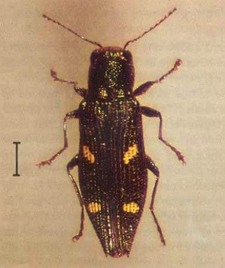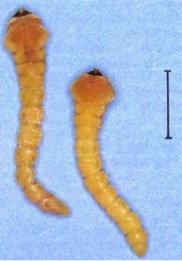PESTS AND DISEASES OF FORESTRY IN NEW ZEALAND
Beech buprestid
Scion is the leading provider of forest-related knowledge in New Zealand
Formerly known as the Forest Research Institute, Scion has been a leader in research relating to forest health for over 50 years. The Rotorua-based Crown Research Institute continues to provide science that will protect all forests from damage caused by insect pests, pathogens and weeds. The information presented below arises from these research activities.
Forest and Timber Insects in New Zealand No. 63: Beech buprestid.
Revised 2009
Based on R.H. Milligan (1985)
Insect: Nascioides enysi (Sharp) (Coleoptera: Buprestidae)

Fig. 1 - Beech buprestid adult.
The line shows natural length.

Fig. 2 - Beech buprestid larvae. Note the greatly expanded and flattened prothorax with the V- shaped marking.
The line shows natural length.
Type of injury
Both adult and larva of the beech buprestid feed on native beech (Nothofagus). The adults eat leaves and the larvae make broad, shallow mines under the bark of felled or dying trees, or in dead parts of living trees. Gum-filled mines of newly-hatched larvae may occur in the bark of trunks and branches of living trees, especially those which are suppressed or subject to seasonal droughts. If the newly-hatched larvae reach the cambium of living trees gum flecks may become included in the wood and will cause a minor timber defect.
Hosts
The beech buprestid occurs on all species of New Zealand Nothofagus.
Distribution
This native insect is present throughout New Zealand.
Economic importance
Severe defoliation by beech buprestid adults has never been seen in the forest, and timber defects caused by the larvae are insignificant in comparison with those caused by Platypus beetles (Leaflet No.37) and other agents.
At one time it was thought that the mines of successive generations of newly-hatched larvae so damaged the phloem of healthy pole-sized Nothofagus fusca (red beech) that the trees died. However, it is now believed that early stage larvae which penetrate the cambium survive only where host tissues are already so debilitated that they are incapable of normal gum reaction to wounding. Larvae develop only in trees or parts of trees killed by other agents.
It was also thought that the yearly repetition of mining injuries to the inner bark in the vicinity of preferred egg-laying sites on roughened bark of branches caused debility or death of branches, or appreciably affected the growth of the tree. However, this is no longer regarded as true since the conducting elements of the phloem damaged by the newly-hatched larvae appear to be adequately replaced by new tissue.
Description
The adult is a beetle 7-10 mm long and 1.7-3.2 mm across at its widest point (Fig. 1). The body surface is iridescent, appearing mainly dark green from some angles and purplish from others. There are two pairs of orange spots on the elytra (wing covers). The front of the male's head between the eyes is shiny coppery-red, and the inner surface of the forelegs is brilliant green. Corresponding parts of the female appear dull purple. The antennae are slender with serrated end segments. The elytra are ribbed and taper to the rear.
The fully-grown larva is creamy-white and about 20 mm long (Fig. 2). The head is so deeply embedded in the prothorax that little more than the jaws project. The greatly expanded and flattened prothorax, maximum width 5 mm, has a V-shaped marking on the top and an inverted T-shaped marking on the underside. The two segments just behind the prothorax taper abruptly to the abdomen which is about half as wide as the prothorax. The two end segments of the abdomen are the narrowest with the last being nearly conical. Recently hatched larvae are 2-3 mm long and 0.3 mm wide, and the prothorax is less obviously flattened and widened. Later-stage larvae resemble mature larvae except in size.
The only other buprestid known in New Zealand beech forests is Maoraxia eremita (White), but larvae of this are found only in decaying wood of small branches of Nothofagus and other hardwoods.
Life history and habits
The beetle lays eggs in small groups under bark scales, in narrow fissures, and at the edges of wounds. Roughened parts of the bark are preferred. The average number of eggs laid has not been determined. Eggs take about a month to hatch. The larvae bore directly through the outer bark and make feeding mines in the thick-walled phloem, mainly along the length of the tree. Occasionally they may penetrate this thick-walled region and reach the narrow zone of thin-walled, most recently formed phloem, or even the cambium. When this occurs a vigorous gum response is evoked in healthy tissues, the mines become flooded, and the larvae are killed. Less vigorous host reactions occur in the outer phloem because although larval excrement in older parts of the mine is always impregnated with gum a short region immediately behind the larva remains clear. Larvae which remain in the outer phloem appear able to survive from one oviposition season to the next.
If branches are broken during storms, or if stems are subjected to severe and sustained moisture stress (as in windthrown, felled, or Platypus-killed trees) the tissues close to the cambium lose their capacity to produce gum and the larvae then move inwards. Once they reach this more nutritious zone their development continues unchecked. In dying trees, the larval mines which first reach the cambium are still made predominantly lengthwise along the trunk, and do not encroach on the sapwood. Only the mines of later larvae engrave the sapwood, and then only very shallowly.
When the larvae are fully grown they make pupal cells in the bark. The oval exit holes made by emerging beetles measure up to 2.5 by 3.6 mm.
Morgan (1966) states that larvae shed their skins five times to become fully grown, and take one year to complete their life cycle under thin bark and two years under thick bark. Adults can be found from November to February. Their various activities depend on temperature: below 10 degrees C the beetles are inactive; from 13 degrees C they feed on foliage; above 16 degrees C they mate, but do not lay their eggs if temperatures are below 22 degrees C. Sunlight intensifies their activities and as light diminishes higher threshold temperatures are required.
Control
No control measures against this insect are necessary.
If the beetle lays eggs in temporarily stressed trees many young larvae are killed by gum reaction. If the larvae develop in thin-barked trees up to 70% of those reaching the later stages of development are likely to be parasitised by the braconid wasp Doryctes pallide Gourlay. Larvae of the colydiid beetle Bothrideres obsoletus Broun are also parasitic on the larvae or pupae but are not often found. In thick-barked hosts, where D. pallida does not occur, up to 90% of late-stage larvae are killed by fungi.
Bibliography
Conway, M.J. 1949: Beetle damage to beech forest. New Zealand Journal of Forestry 6: 67-68.
Dumbleton, LJ. 1939: Buprestid beetles in New Zealand. New Zealand Journal of Forestry 4: 256.
Milligan, R.H. 1972: A review of beech forest pathology. New Zealand Journal of Forestry 17: 201-211.
Milligan, R.H. 1974: Insects damaging beech (Nothofagus) forests. Proceedings of the New Zealand Ecological Society 21: 32-40.
Milligan, R.H. 1985: Nascioides enysi (Sharp), (Coleoptera: Buprestidae). Beech buprestid. New Zealand Forest Service, Forest and Timber Insects in New Zealand No. 63.
Morgan, F.D. 1966: The biology and behaviour of the beech buprestid, Nasciodes enysi (Sharp) (Coleoptera: Buprestidae) with notes on its ecology and possibilities for its control.
Transactions of the Royal Society of New Zealand (Zoology) 7: 159-170.
Stuart, K.M. 1955: A note on secondary sexual dimorphism in Nascioides enysi (Sharp), (Coleoptera, Buprestidae). New Zealand Entomologist 1(5): 14-15.
This information is intended for general interest only. It is not intended to be a substitute for specific specialist advice on any matter and should not be relied on for that purpose. Scion will not be liable for any direct, indirect, incidental, special, consequential or exemplary damages, loss of profits, or any other intangible losses that result from using the information provided on this site.
(Scion is the trading name of the New Zealand Forest Research Institute Limited.)

 Farm Forestry New Zealand
Farm Forestry New Zealand

